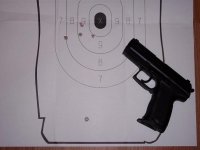Variations Of The Double Tap
Variations of the “Double Tap”
Based on material posted by Rosco Benson on
www.tacticalforums.com on
12-13-2002.
There is much confusion over the term “double tap” and what it actually means.
A “double tap” is a quick two shot burst fired on a single target. We fire two shots because we may miss with the first or the first hit may not cause incapacitation rapidly enough to protect us from a deadly assault.
Within the concept of the “Double Tap”, Jeff Cooper at API taught three variations, the “Hammer”, the “Dedicated Pair” and the “Controlled Pair”. Many people believe the specific technique of the “Hammer” is the same as the “Double Tap” but that is not exactly true. The “Double Tap” is the general category of technique and the “Hammer”, “Dedicated Pair”
and “Controlled Pair” are specific applications of that technique.
The normally accepted standard of accuracy is that both hits remain in the A zone on an IPSC, IDPA or Paladin silhouette target. A 8 inch paper plate makes a field expedient repair center for practice purposes.
The “Hammer” is a flash sight picture – shot #1 – recover from recoil – shot #2.This is a technique best utilized where multiple hits with coarse accuracy are required very quickly at close range. Whether one can successfully get the required hits using the “hammer” is certainly influenced by recoil and it manifests itself as the distance at which one can keep his “hammer” delivered pairs acceptably placed.
One sight picture, two shots. A “Hammer’s” best utility is to put two hits on target in a hyper-rapid interval, and with practice one can fire a “dedicated pair” or a “controlled pair” nearly as fast with greater accuracy.
The “Dedicated Pair” is an aimed sight picture – shot #1 – recover from recoil – flash sight picture – shot #2. The “Dedicated Pair” differs from the “Controlled Pair” only in that, while the sights are seen for the second shot, no attempt is made to correct the sight picture. The sights are seen for the second shot only to verify alignment that has already been achieved through a well-practiced follow-through. Since the eye can pick up images incredibly quickly, many shooters who think they are firing “hammers” are really firing “controlled pairs”.
The “Controlled Pair” goes like so: aimed sight picture – shot #1 – recover from recoil – reacquire aimed sight picture as needed – shot #2.
In a “controlled pair” the interval between the shots can be very short or quite long. The length of the interval is influenced by the degree of marksmanship difficulty required by circumstance, the recoil of the weapon, the type of trigger, and so forth.
Through practice, experienced shooters know how much time they need to deliver a “double tap” on a particular target at a particular distance under particular circumstances. A charging target at 5 yards might best be engaged by a “Hammer” where a partial target behind hard cover at 15 yards would require a “Controlled Pair”. Most situations are best resolved with a “Dedicated Pair”.
These descriptions of technique are most useful to newer shooters trying to conceptualize marksmanship skills and techniques over the continuum of situations where they might need to be applied. With practice, experienced shooters know how precise a trigger stroke and how perfect a sight picture they need to deliver a shot or shot on target under different parameters.


